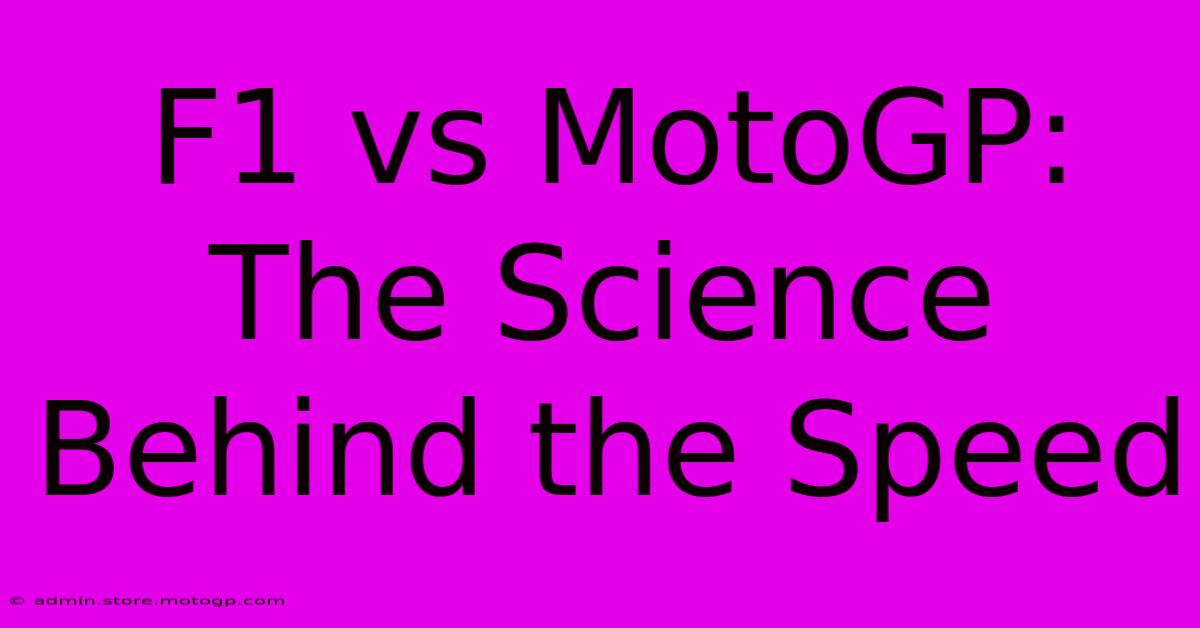F1 Vs MotoGP: The Science Behind The Speed

Table of Contents
F1 vs MotoGP: The Science Behind the Speed
Formula 1 and MotoGP. Two titans of motorsport, each captivating millions with their breathtaking speed and precision. But which is faster? The answer isn't as straightforward as you might think. This article delves into the science behind the speed of both, comparing the contributing factors and ultimately highlighting the nuances that make each discipline unique.
The Physics of Speed: A Tale of Two Wheels and Four
Both F1 and MotoGP cars are marvels of engineering, pushing the boundaries of what's possible. However, their approaches to generating speed differ significantly.
Aerodynamics: Downforce vs. Drag
Formula 1: F1 cars rely heavily on aerodynamics to generate incredible downforce. This downforce presses the car to the track, allowing for higher cornering speeds. While this enhances speed through corners, it also increases drag, resisting forward motion on straights. Think of it as a trade-off: superior cornering speed at the expense of some top speed. The complex designs of F1 wings and diffusers are constantly tweaked to find the optimal balance.
MotoGP: MotoGP bikes, while also benefiting from aerodynamics, prioritize minimizing drag to maximize top speed. While some downforce is beneficial for stability, the emphasis is on reducing resistance to airflow to achieve the highest possible straight-line velocities. The sleek, streamlined design of MotoGP bikes reflects this priority. Recent innovations, such as winglets, aim to find a better balance between downforce and drag.
Power-to-Weight Ratio: A Crucial Factor
The power-to-weight ratio is arguably the most significant determinant of outright speed in both disciplines.
Formula 1: F1 cars boast incredibly powerful engines, typically exceeding 1000 horsepower. Combined with their relatively lightweight construction (around 798kg minimum weight), they achieve a phenomenal power-to-weight ratio. This translates to rapid acceleration and high top speeds on straights.
MotoGP: MotoGP bikes, though lighter than F1 cars, possess significantly less horsepower (around 260 hp). However, their considerably lower weight (less than 157kg) still results in a remarkable power-to-weight ratio. This allows for explosive acceleration out of corners, compensating for the lower top speed compared to F1 cars.
Tire Technology: Grip and Speed
Tire technology plays a crucial role in both sports. The grip generated by the tires directly impacts acceleration, braking, and cornering speeds.
Formula 1: F1 cars use significantly wider tires than MotoGP bikes, providing immense grip. This allows for higher cornering speeds and faster acceleration. The tire compounds and construction are constantly refined to optimize performance in various track conditions.
MotoGP: MotoGP bikes utilize specialized tires designed for extreme lean angles and rapid changes in direction. The relatively smaller contact patch compared to F1 tires necessitates precise rider control and contributes to the thrilling spectacle of MotoGP races.
The Verdict: It's Complicated!
Determining whether F1 or MotoGP is "faster" depends on what you mean by "fast."
-
Top Speed: F1 cars generally achieve higher top speeds on straights. Their powerful engines and aerodynamic design (albeit with higher drag) enable higher velocities on long straights.
-
Lap Time: The overall lap time is highly track-dependent and often sees MotoGP bikes posting faster lap times on certain tracks. Their agility and superior cornering speeds allow them to navigate tighter circuits more effectively.
Ultimately, both F1 and MotoGP represent the pinnacle of automotive and motorcycle racing technology. Each discipline has its unique strengths, emphasizing different aspects of speed and performance. The comparison is less about determining a clear winner and more about appreciating the distinct scientific approaches that make both so spectacular.

Thank you for visiting our website wich cover about F1 Vs MotoGP: The Science Behind The Speed. We hope the information provided has been useful to you. Feel free to contact us if you have any questions or need further assistance. See you next time and dont miss to bookmark.
Featured Posts
-
Moto2 Motorcycles Unleash Your Potential
Feb 20, 2025
-
Gp Results Stay Informed Stay Healthy
Feb 20, 2025
-
Formula 1 Parking Park Smart Race Happy
Feb 20, 2025
-
Cota Grounds Pass Feel The Adrenaline
Feb 20, 2025
-
Qualifying Results Moto Gp Grid Set For A Dramatic Showdown
Feb 20, 2025
